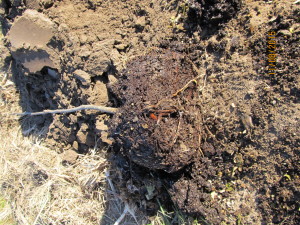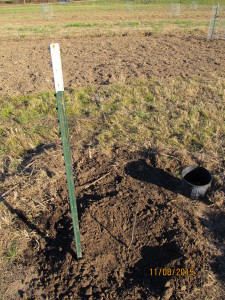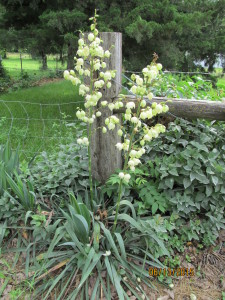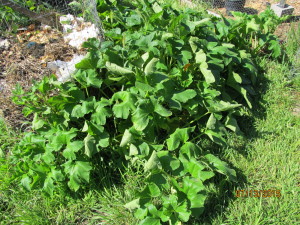The same bunch of Easter flowers that bloomed weeks before their neighbors last year have bloomed early(March 7) again this year.
And, the elderberry buds are popping out new leaves.
In the two pictures below the brown areas are bare ground where I transplanted pecan trees from pots into the field during November.
The following paragraphs list some of the work performed on the property in 2015.
Some common tasks performed on all young trees in the field included:
A. pruned trees in February
B. hoed weeds during the growing season
C. fertilized trees in March and June
D. tried to train trees to grow as I wished by pruning during the growing season
E. watered trees during dry periods
Work on the pecan trees included:
A. bought 45 grafted pecan trees in pots and transplanted them into the field
B. nursed 15 one-year old pecan seedlings in pots that I had sprouted from seed in May through the Summer
C. transplanted those 15 seedling pecan trees into the field in the Fall
D. grafted 15 pecan seedlings in the field – of which only 5 grafts were successful
Currently there are about 250 young pecan trees in the field.
Work with the Chinese chestnut trees included:
A. transplanted 7 seedling Chinese chestnuts that I had sprouted from seeds into the field
B. bought 3 grafted Chinese chestnuts in pots and transplanted them into the field
Currently there are 60 chestnut trees in the field.
In May I sprouted pecan seed nuts and nursed the young seedlings through the summer. Now, there are 40 sprouted pecan seedlings bedded down in a straw bale fort to protect them from the winter weather until next Spring.
Although all the trees were pruned in February, pruning is a continual process during the growing season. The purpose is to train the trees to grow limbs in a specific manner. A major problem that I have is that after I prune a tree, the tree often does not agree with my decisions. It then grows limbs in places that I do not want limbs to grow. Looking back I can sometimes see that the trees decision was better than mine. But, that is rather frustrating. Hopefully, more experience with pruning and tree growth will bring the decisions of the tree and my pruning decisions into better agreement.
Other tasks involved general maintenance of the property:
A. mowing all the grassy areas two or three times to control the serecia lespedeza and other weeds
B. cutting down thorny locust trees and autumn olive bushes
C. putting up bird houses for the bluebirds – made 3 new houses
D. putting up raptor perches for the hawks and owls to use when they are looking for mice – made 6 perches
E. painting the roof of the building
F. working on the fences
G. making storage carts that can roll around on the concrete floor of the garage – made 6 carts
This blog was also started as a record of activities.
So much for 2015 – now it is time to move on to 2016 and more of the same!
From late October into November I transplanted 60 pecan trees from three gallon pots into permanent field locations where I hope they will grow and produce pecan nuts. Although five trees replaced failed trees that were planted in previous years, 55 trees were planted into new locations. Due to the lack of rain from late August to the latter part of October, I delayed transplanting while hoping that rain would reduce the number of times I have to water the trees after transplanting.
The following picture shows a location after scraping away the vegetation but before digging the transplant hole.
After digging the hole it appears as in this picture.
Note that the shape of the hole appears as if a donut was pressed down into it – the “donut hole” is a small mound of dirt in the center of the hole that was not disturbed during the digging process. By resting the transplant tree on the undisturbed donut hole it should not sink any lower as it might if the dirt under the tree root ball was loose fill dirt. And, in the next picture the depth of the hole is checked by placing the potted tree on top of the donut hole. The tree should set down low enough that after transplanting the root ball will be covered with one or two inches of dirt. The potting media in the root ball is composed of very porous material, and, covering it with a layer of dirt will reduce evaporation that might dry out the root ball.
Removing the root ball from the pot and looking at the bottom reveals that some of the roots grew around the bottom of the root ball trying to escape the pot as shown in the next picture.

Large roots that encircle the root ball could cause problems as the tree roots grow in the ground, so, I cut them off as in the next picture.

The trimmed root ball was then placed on top of the donut hole and the hole filled with dirt. A low ridge of dirt encircles the tree to provide a catchment for water as in the next picture.
After removing the “t” from a t-post it is driven into the ground about 15 inches away from the tree on the north side. If the “t” is left on the post, the roots might grow over it and make it more difficult to remove the post in a few years when the post is no longer required.

Next the tree is watered to settle the soil close around the roots and a fence ring is placed around it and fastened to the t-post. The fence ring is made of 2″x4″ welded wire and is four feet high and about ten feet long. Without a fence ring to protect the tree the deer often come up and sample the leaves and stem. Sometimes they will even try to pull the tree out of ground or tromp on it. With all the tracks they leave they seem to think it is their duty in inspect my work during the night after I finish.
In the last part of October there were two days when swarms of beetles filled the air around the steel building on my property. One day was after two days of rain and the other day was after a day of strong winds. There were many configurations of spots on their backs as the following picture shows. I wonder which are beneficial and which might be detrimental to the plants that I am trying to grow.
In the second picture they appear to be searching for an entry to the building and as a place to hole-up for the Winter.
When one of the beetles is crushed, the aroma reminds me of the times when my mother was not happy about how they invaded the ceiling light fixtures and were roasted.
The Fall webworms have been very active this year. The eggs are attached to a leaf in a small white silky mass. The resulting caterpillars create webs to protect themselves from predators while they eat the leaves inside the web and grow. Some trees have been completely defoliated. The following picture shows a pecan tree with numerous webs.
The caterpillars do not seem to bother oak trees very much. The following picture shows a tall hickory tree completely engulfed whereas the nearby oak trees show very little effect.
Seeing the pretty blooms of weeds in the field reminds me of something I need to do this Winter when the weather cools off. I need to study what plants grow in the fields and learn to identify most of them. But, care needs to be taken that the beauty of the blooms does not over rule any needed responses to undesirable or noxious weeds. The following pictures show blooms of weeds/wildflowers in the field.
Also, I need to study the manual for my camera so I can take better close up pictures.
This last week the flowers of the lily that probably has more names than any other flower popped out of the ground, grew stems about two feet tall, and produced some beautiful flowers. This all happened in a period of about four days. What is your name for the lily in the following pictures?
How about surprise lily, magic lily, nekkid lady, ressurection lily, etc. It is interesting to note that this lily produced leaves early in the Spring that then died away before the flowers decided to pop out of the ground.
Previous owners of the property planted various flowers and trees at various sites that have outlived their ownership. A previous post showed some of the early blooms – here are a few that bloomed later. Do you know their names?

Two years ago I planted a sage bush which produces pretty purple blooms – picture below.
How about a picture of Socrates’ poison plant (hemlock)?
The white flowers at the top of the five to ten foot tall stalk look like fine frilly lace. This year there seem to be a lot more clusters of these five to ten foot tall plants located along creek banks than in the previous two Springs.
Yesterday the temperature reached 96 degrees and I was not the only thing that showed the effects.
After seeing the somewhat wilted squash vines that are growing out of my compost bin/pile, I remembered the same thing in my mothers gardens when I was growing up. The following picture shows some of the big squash leaves that are drooping in the hot weather.
And, here is a wider picture of the squash vines growing out of the compost pile as they continue to conquer territory.

Now I need to decide if it is worth continuing to walk around the encroaching plant with the potential return of a few squash, or, should I chop the plant down and add it to the compost pile.
Many of the pecan seedling trees in the field were damaged by what appears to be the work of June beetles.
When inspecting the damaged trees, no culprits were found on the leaves. That seems to be the nature of June beetles – hiding during the daylight hours and partying at night. There are good descriptions on the Northern Pecan blog.
The leaflets on some of the trees were completely destroyed – leaving only the stems of the leaves – see the following two pictures.
A second type of bug damage occurs where the attack location starts at the tip of the growing shoot. Adjacent leaves are glued together into a mass where a worm feeds inside – see the following picture.
With other bugs gnawing on the leaves it amazing how the pecan trees keep trying to come back as the following picture shows.